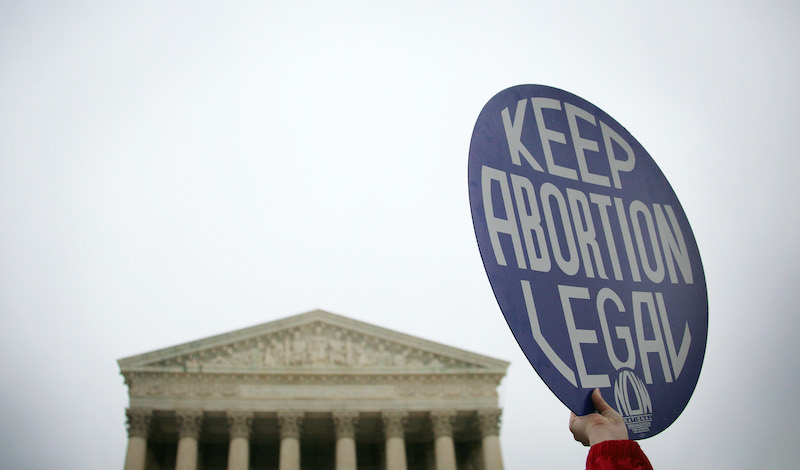
Scholars offer suggestions for protecting abortion rights if the Supreme Court overturns Roe v. Wade.
A leaked copy of a draft of a U.S. Supreme Court majority opinion appears to indicate plans to overturn almost 50 years of precedent granting constitutional protection to the right to get an abortion.
“If the Court does overturn Roe, it will fall on our nation’s elected officials at all levels of government to protect a woman’s right to choose,” President Joseph R. Biden said in response to the leak.
In a report issued last year, two experts from the Center for American Progress detail what President Biden’s call to action could look like in practice. In the report, Jamille Fields Allsbrook and Nora Ellmann predict that the Court will overturn Roe and provide policy suggestions for federal and state governments to protect abortion rights.
In Roe v. Wade, the Court found that the right to choose an abortion was fundamental under the 14th Amendment. The Court has since repeatedly upheld this interpretation. Yet, as Allsbrook and Ellmann explain, in more recent years, the Court has slowly chipped away at this right.
In upholding states’ restrictions on access to abortion, a more conservative Court has indicated a shift in its attitude towards abortion access. As Allsbrook and Ellmann predict, “the current high court justices’ judicial philosophy suggests that they may be more willing to upend precedent and the rule of law to further erode Roe’s protections or overturn it entirely.”
The leaked draft of Justice Alito’s majority opinion rejects any explicit right to an abortion. But Allsbrook and Ellmann emphasize the potential harm of overturning Roe.
In 2019, 58 percent of women of reproductive age lived in states deemed “hostile to abortion rights.” Rules limiting insurance coverage, large distances between abortion clinics, and requirements for multiple visits and to hear the heartbeat before an abortion already severely limit access to abortion.
One study found that if the Court reversed the decision in Roe, abortion will likely be prohibited in 24 states and 3 territories.
Allsbrook and Ellmann highlight that these barriers disproportionately affect marginalized communities, in particular, because “Black women disproportionately reside in states with abortion restrictions.” In addition, insurance restrictions limit people with fewer economic resources from accessing abortion. Due to pay inequities, this means that restrictions disproportionately burden “Black, Latina, and Indigenous women—as well as people with disabilities, transgender people, and young people.”
Allsbroook and Ellmann insist that in the absence of continued constitutional protection of abortion rights, they must be enacted into statutory law by state and federal lawmakers.
They encourage Congress and state lawmakers to codify the right to get an abortion and go beyond Roe, which they describe as establishing a minimum floor for abortion rights. They emphasize that state lawmakers should not wait for federal law before enacting these policies, whether through “legislation, ballot initiatives, or constitutional amendments.”
Lawmakers can further strengthen the right to an abortion by enacting laws that prohibit unnecessary restrictions on abortion care, such as the Women’s Health Protection Act, a bill introduced in the 116th Congress.
Even if legislation protects the right to abortion, Allsbrook and Ellmann contend that courts will play a significant role in assessing the validity and necessity of abortion restrictions. They urge policymakers to prioritize appointing judges with a diverse range of identities and with a history of supporting abortion rights.
Allsbrook and Ellmann encourage lawmakers to mitigate financial barriers to abortion by removing or limiting restrictions on funding abortion through insurance. They also argue that Congress should repeal the Hyde Amendment, which prohibits federal funds from paying for most abortions.
Furthermore, many states prevent even private insurance from paying for comprehensive abortion care. At the federal level, requirements in the Affordable Care Act discourage private insurance carriers from covering abortion services. Billing requirements for abortion services in a 2019 regulation have also led private insurance carriers to drop coverage for abortion services, note Allsbrook and Ellmann.
In the absence of universal health care coverage that includes abortions, Allsbrook and Ellmann advocate that states and federal government revoke all requirements and prohibitions that restrict access to abortion.
As Roe’s protection of abortion rights is threatened, Allsbrook and Ellmann emphasize the importance of strengthening and expanding alternative methods for obtaining abortion care. Abortions can be provided through a procedure or medication, at a clinic, or at home. Medication and care through telehealth services have increased during the pandemic and they can provide a safe, accessible abortion option.
Medication abortion, which consists of two drugs, mifepristone, and misoprostol, is approved by the U.S. Federal Drug Administration (FDA). More than 95 percent effective, medication abortion only has serious adverse effects occur in less than 0.5 percent of cases.
FDA has placed a risk evaluation and mitigation strategy (REMS) on mifepristone, meaning the drug is subject to “certain requirements around prescribing, dispensing and taking the medication.” These limitations include preventing distribution of the medicine by mail or pharmacy, which makes providing an abortion via telehealth difficult. Allsbrook and Ellmann note, however, that the drug has fewer proven adverse reactions than various popular medications, including Tylenol and Viagra. Allsbrook and Ellmann argue that FDA should lift the REMS on mifepristone because of its relatively limited health risks and its ability to make abortion significantly more accessible.
The public will need to wait to see whether the Supreme Court ultimately overturns Roe v. Wade as indicated by the leaked draft opinion. But even if Roe is not overturned, Allsbrook and Ellmann provide a roadmap for strengthening abortion protection.



